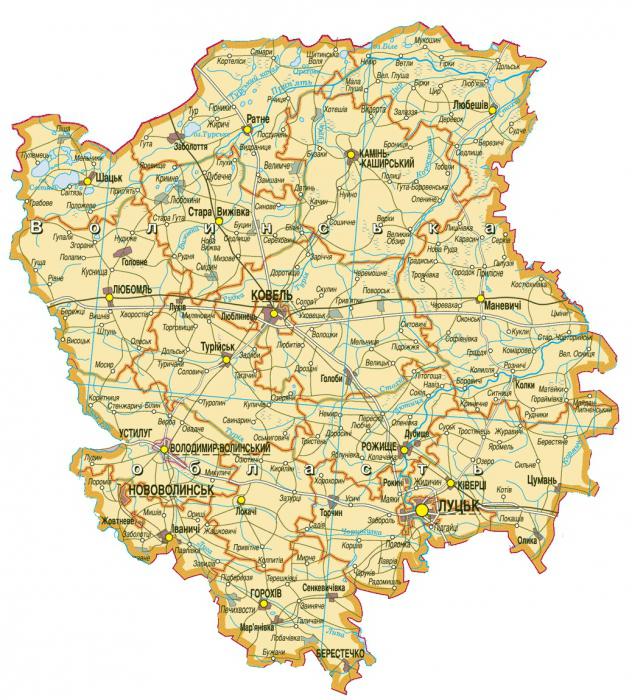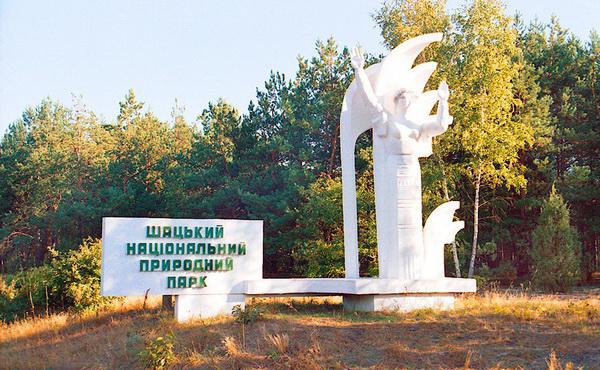The Volyn region (the map of Ukraine shown in this article demonstrates its location) is located in the northwestern part of Ukraine, in the Polesye zone. Its northern part borders with Belarus (Brest region), the eastern part with the Rivne region, the southern part with the Lviv region, and the western one with Poland.
Volhynia is a historical place, here from time immemorial important things have been done in the history of Russia, sometimes tragic and difficult. Such an eventful fate of the region could not but reflect on its appearance, not leave a mark in the form of architectural and historical sights, which in Volyn number more than eight hundred.
Relief and climate
The terrain is mostly flat. Most of the territory is located within the Polesskaya lowland, and the smaller - southern - is located on the northwestern outskirts of the Volyn Upland, cutting off to the north with a ledge of 20-60 meters. Volyn region is characterized by temperate continental climate. Winter is mild, summer is warm. The average temperature in January is minus 4.5 degrees Celsius, in July - plus 18.6 degrees. Precipitation is 550-600 mm per year. In the northern part of the region, the Pripyat River flows . The right tributaries of this waterway (Turya, Styr and Stohod) cross the region from south to north. Along the border with Poland, another river flows - the Western Bug. In total, over 130 rivers flow through the region, their total length is more than three thousand kilometers. All water arteries belong to the basins of the Western Bug and the Dnieper. Most water bodies originate outside its territory. Map of Volyn region (Ukraine) is replete with images of rivers and streams.

Geography
The soils of the forest-steppe part of the Volyn region are podzolized gray and dark gray, as well as chernozems. The Polessye part is characterized by sod-podzolic, as well as various marsh (including peat). The middle strip is sod-podzolic and humus-carbonate (the most fertile). Volyn region is conditionally divided into three zones - forest-steppe, South Poless and North Poless. The first two are located in the Volyn-Podolsk Upland. Severopolsskaya occupied more than 75 percent of the region’s territory. The peculiarity of this zone is a flat lowland covered with swamps and forests. Volyn has large reserves of mineral raw materials - coal, carbonate rocks, peat, natural gas, sapropel, but most of them have no industrial significance.
Volyn Region: Areas
The region is divided into sixteen administrative districts: Vladimir-Volynsky, Gorokhovsky, Ivanichevsky, Kivertsovsky, Kovelsky, Kamen-Kashirsky, Lokachinsky, Lutsky, Lyubeshovsky, Lyubomlsky, Manevichsky, Ratnovsky, Rozhischensky, Starovyzhevsky, Turisky and Shatsky. In total, there are 1087 settlements on its territory, of which 1054 are rural, 33 urban, including 22 urban-type settlements and 11 cities. The Volyn Region (Lutsk - the administrative center) has four cities of regional significance (Lutsk, Kovel, Vladimir-Volynsky, Novovolynsk) and seven cities of regional significance (Gorokhov, Berestechko, Kamen-Kashirsky, Lyuboml, Kivertsy, Ustilug and Rozhishche).
Economy
The main industries of the region are agriculture, transport and industry (mainly food). The leading economic sector is the agricultural sector, providing half of the total product. Thus, agriculture has taken a course towards specialization in animal husbandry of the meat and dairy sector, in addition to the production of sugar beets, potatoes, grains and vegetables. The manufacture of industrial products employs 167 enterprises. The main industries are food, fuel, chemical and mechanical engineering. The enterprises of the Volyn region produce bearings, water meters, control devices, machinery for feed production and animal husbandry, plastic products, linoleum, roofing material, fabrics, bricks, furniture, canned goods, pasta, sausages, confectionery and vodka products and much more. The private sector has nearly four thousand small enterprises and thirty thousand physical entrepreneurs. Due to this, a tenth of the working population of the Volyn region is occupied. Small enterprises in the region produce almost ten percent of the products, provide a fifth of budget revenues at all levels.

Industry
The raw material base of Volyn is represented by the following minerals: natural gas, coal, phosphorite, copper, building chalk, building stone, helium, sapropel. In addition, I mine brick and tile raw materials, peat, glass and building sand, cement raw materials here. The food industry of the region is represented by more than fifty enterprises, the flagship of this industry is Vladimir-Volynsky, Gorokhovsky, Gvidavsky sugar factories. The machine-building complex is headed by Lutsk Bearing Plant LLC, the industrial center of the Volyn Region. He is a monopolist in the production of needle and tapered bearings. Another unique engineering plant is OJSC Electrothermometry, which produces more than eighty percent of various meters in Ukraine. Among the enterprises producing construction materials, one can note the “Lutsk cardboard and roofing mill”.
Agriculture
Volyn region is known for its dairy and beef cattle breeding and crop production (sugar beets, grain, flax, potatoes). Agricultural producers maintain economic relations with many countries of the CIS, Western and Eastern Europe. The following products are produced for export: milk powder, sugar, meat products and others. As a negative, a continuing trend towards a reduction in the number of goats, sheep and cattle can be noted.
Population
Recently, there has been a slight increase in the population of Volyn, unlike other regions of Ukraine, where the population continues to decline every year. The demographic situation in the region differs from the all-Ukrainian one in higher birth rate and lower in mortality. As a result, the natural population decline birth rate exceeds the natural population decline.
The ethnic composition in the region is homogeneous - 95 percent of Ukrainians. In large cities of Volyn, the proportion of Ukrainians, against the background of the total number, is slightly decreasing, while in the districts, it sometimes reaches 99 percent. Russians, in the region as a whole, account for four percent. Belarusians, Czechs, Poles, Germans, Slovaks and representatives of other nationalities live here.
Religion
Volyn region is characterized by a dominant religious movement - Orthodox Christianity. The confessional structure of which is represented by the predominance of the communities of the Ukrainian Orthodox Church of the Moscow Patriarchate, the share of the Kiev Patriarchate is much lower. It can be noted that Old Believer communities are completely absent on the territory of the region, while unitarianism has a small distribution.
It is interesting to know.
1. "Volyn miracle." In the Manevichevsky district near the village of Okonsk in a small lake there are Okonsky sources. What are they? These are two very powerful healing springs, beating year-round, they do not freeze even in the most severe frosts. What is surprising is the fact that this healing water is completely amenable to carbonation.
2. Karst lake Svityaz, located near the urban-type settlement Shatsk (Volyn region), has a maximum depth of fifty-four meters. It is the deepest in Ukraine.
3. In the Zimnensky Svyatogorsky Orthodox monastery you can see the unique miraculous icon of the Mother of God. It is considered one of the most powerful shrines of the Christian church, which during the Soviet period miraculously disappeared.
4. F. Kaplan was born on Volyn land, who in August 1918 attempted to assassinate the leader of the world proletariat V. I. Lenin. An interesting fact is that, on the recommendation of Dmitry Ulyanov (Lenin’s brother), Kaplan was sent to the Kharkov Eye Clinic in 1917, where she underwent a successful operation - she restored her eyesight. And a year later she committed a terrorist attack.
5. In the fifteenth century, during the reign of King Vytautas, here in Lutsk, a congress of the greatest rulers of Europe took place. They discussed the likely threat from the Ottoman Empire.
6. On the banknote of 200 hryvnias next to Lesia Ukrainka is an image of Lubart Castle in Lutsk.
7. In Kovel is the largest monument to the poet Taras Grigorievich Shevchenko. Its weight was twenty tons and a height of more than seven meters, it is installed on a four-meter hill.